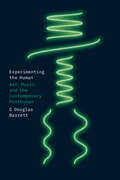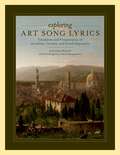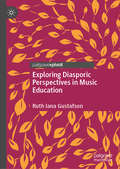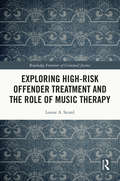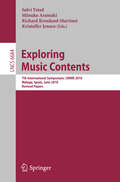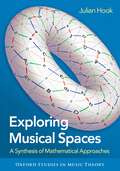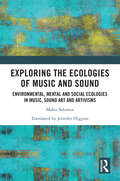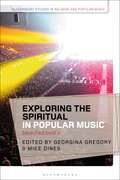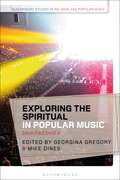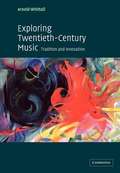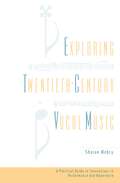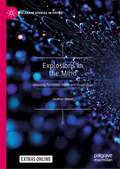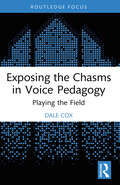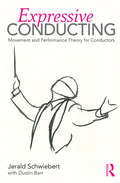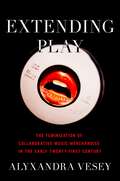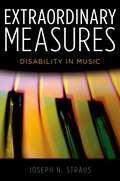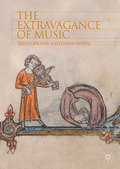- Table View
- List View
Experimenting the Human: Art, Music, and the Contemporary Posthuman
by G Douglas BarrettAn engaging argument about what experimental music can tell us about being human. In Experimenting the Human, G Douglas Barrett argues that experimental music speaks to the contemporary posthuman, a condition in which science and technology decenter human agency amid the uneven temporality of postwar global capitalism. Time moves forward for some during this period, while it seems to stand still or even move backward for others. Some say we’re already posthuman, while others endure the extended consequences of never having been considered fully human in the first place. Experimental music reflects on this state, Barrett contends, through its interdisciplinary involvements in postwar science, technology, and art movements. Rather than pursuing the human's beyond, experimental music addresses the social and technological conditions that support such a pursuit. Barrett locates this tendency of experimentalism throughout its historical entanglements with cybernetics, and in his intimate analysis of Alvin Lucier’s neurofeedback music, Pamela Z’s BodySynth performances, Nam June Paik’s musical robotics, Pauline Oliveros’s experiments with radio astronomy, and work by Laetitia Sonami, Yasunao Tone, and Jerry Hunt. Through a unique meeting of music studies, media theory, and art history, Experimenting the Human provides fresh insights into what it means to be human.
Exploring Art Song Lyrics: Translation and Pronunciation of the Italian, German & French Repertoire
by Jonathan RetzlaffDrawing generously from four centuries of Italian, German and French art song, Exploring Art Song Lyrics embraces the finest of the literature and presents the repertoire with unprecedented clarity and detail. Each of the over 750 selections comprises the original poem, a concise English translation, and an IPA transcription which is uniquely designed to match the musical setting. Enunciation and transcription charts are included for each language on a single, easy to read page. A thorough discussion of the method of transcription is provided in the appendix. With its wide-ranging scope of repertoire, and invaluable tools for interpretation and performance, Exploring Art Song Lyrics is an essential resource for the professional singer, voice teacher, and student.
Exploring Diasporic Perspectives in Music Education
by Ruth Iana GustafsonThis book challenges simplified claims of racial, national, and ethnic belonging in music education by presenting diaspora as a new paradigm for teaching music, departing from the standard multicultural guides and offering the idea of unfinished identities for musical creations. While multiculturalism—the term most commonly used in music education—had promised a theoretical framework that puts classical, folk, and popular music around the world on equal footing, it has perpetuated the values of Western aesthetics and their singular historical development. Breaking away from this standard, the book illuminates a diasporic web of music’s historical pathways, avoiding the fragmentation of music by categories of presumed origins whether racial, ethnic, or national.
Exploring High-risk Offender Treatment and the Role of Music Therapy (Routledge Frontiers of Criminal Justice)
by Louise A. SicardExploring High-risk Offender Treatment and the Role of Music Therapy explores the treatment delivered to high-risk offenders with complex needs, focusing on sex and violent offenders. The book advocates for the further use of less traditional and creative therapies, in particular, music therapy. The higher the risk, the greater the needs. Offenders with complex needs have a range of factors impacting their abilities and well-being including mental health and learning disorders. Importantly, high-risk offenders commonly present with complex needs and, therefore, require treatment that is highly responsive. Guiding this book is the existing literature and qualitative research, conducted by the author, that sought to gain the perspectives and experiences of practitioners in the field. This included 38 interviews with those that deliver treatment to high-risk offenders and music therapy. This book examines the components of high-risk offender treatment, highlighting the effective elements and the limitations found within the literature and from the perspective of interviewed practitioners. Offering insight into less traditional therapies, the book presents literature surrounding mindfulness, psychodrama and art therapy for high-risk offenders. It is argued that there has been a recent shift towards a creative corrections approach, where less traditional therapies are gaining recognition within offender treatment, as they offer unique and supportive benefits to traditional treatment. This book focuses on examining the role of music therapy for high-risk offenders, mainly through a critical discussion on the relevant literature and qualitative practitioner data. Advocating the further implementation of creative corrections approaches, this book will be of great interest to academics and researchers within the fields of offender treatment and penology, as well as forensic psychologists and those studying or practicing music therapy.
Exploring High-risk Offender Treatment and the Role of Music Therapy (Routledge Frontiers of Criminal Justice)
by Louise A. SicardExploring High-risk Offender Treatment and the Role of Music Therapy explores the treatment delivered to high-risk offenders with complex needs, focusing on sex and violent offenders. The book advocates for the further use of less traditional and creative therapies, in particular, music therapy. The higher the risk, the greater the needs. Offenders with complex needs have a range of factors impacting their abilities and well-being including mental health and learning disorders. Importantly, high-risk offenders commonly present with complex needs and, therefore, require treatment that is highly responsive. Guiding this book is the existing literature and qualitative research, conducted by the author, that sought to gain the perspectives and experiences of practitioners in the field. This included 38 interviews with those that deliver treatment to high-risk offenders and music therapy. This book examines the components of high-risk offender treatment, highlighting the effective elements and the limitations found within the literature and from the perspective of interviewed practitioners. Offering insight into less traditional therapies, the book presents literature surrounding mindfulness, psychodrama and art therapy for high-risk offenders. It is argued that there has been a recent shift towards a creative corrections approach, where less traditional therapies are gaining recognition within offender treatment, as they offer unique and supportive benefits to traditional treatment. This book focuses on examining the role of music therapy for high-risk offenders, mainly through a critical discussion on the relevant literature and qualitative practitioner data. Advocating the further implementation of creative corrections approaches, this book will be of great interest to academics and researchers within the fields of offender treatment and penology, as well as forensic psychologists and those studying or practicing music therapy.
Exploring Music Contents: 7th International Symposium, CMMR 2010, Málaga, Spain, June 21-24, 2010. Revised Papers (Lecture Notes in Computer Science #6684)
by Solvi Ystad Mitsuko Aramaki Richard Kronland-Martinet Kristoffer JensenThis book constitutes the thoroughly refereed post-proceedings of the 7th International Symposium on Computer Music Modeling and Retrieval, CMMR 2010, held in Málaga, Spain, in June 2010. The 22 revised full papers presented were specially reviewed and revised for inclusion in this proceedings volume. The book is divided in five main chapters which reflect the present challenges within the field of computer music modeling and retrieval. The chapters range from music interaction, composition tools and sound source separation to data mining and music libraries. One chapter is also dedicated to perceptual and cognitive aspects that are currently subject to increased interest in the MIR community.
Exploring Musical Spaces: A Synthesis of Mathematical Approaches (Oxford Studies in Music Theory)
by Julian HookExploring Musical Spaces is a comprehensive synthesis of mathematical techniques in music theory, written with the aim of making these techniques accessible to music scholars without extensive prior training in mathematics. The book adopts a visual orientation, introducing from the outset a number of simple geometric modelsthe first examples of the musical spaces of the book's titledepicting relationships among musical entities of various kinds such as notes, chords, scales, or rhythmic values. These spaces take many forms and become a unifying thread in initiating readers into several areas of active recent scholarship, including transformation theory, neo-Riemannian theory, geometric music theory, diatonic theory, and scale theory. Concepts and techniques from mathematical set theory, graph theory, group theory, geometry, and topology are introduced as needed to address musical questions. Musical examples ranging from Bach to the late twentieth century keep the underlying musical motivations close at hand. The book includes hundreds of figures to aid in visualizing the structure of the spaces, as well as exercises offering readers hands-on practice with a diverse assortment of concepts and techniques.
Exploring Musical Spaces: A Synthesis of Mathematical Approaches (Oxford Studies in Music Theory)
by Julian HookExploring Musical Spaces is a comprehensive synthesis of mathematical techniques in music theory, written with the aim of making these techniques accessible to music scholars without extensive prior training in mathematics. The book adopts a visual orientation, introducing from the outset a number of simple geometric modelsthe first examples of the musical spaces of the book's titledepicting relationships among musical entities of various kinds such as notes, chords, scales, or rhythmic values. These spaces take many forms and become a unifying thread in initiating readers into several areas of active recent scholarship, including transformation theory, neo-Riemannian theory, geometric music theory, diatonic theory, and scale theory. Concepts and techniques from mathematical set theory, graph theory, group theory, geometry, and topology are introduced as needed to address musical questions. Musical examples ranging from Bach to the late twentieth century keep the underlying musical motivations close at hand. The book includes hundreds of figures to aid in visualizing the structure of the spaces, as well as exercises offering readers hands-on practice with a diverse assortment of concepts and techniques.
Exploring the Ecologies of Music and Sound: Environmental, Mental and Social Ecologies in Music, Sound Art and Artivisms
by Makis SolomosMakis Solomos explores the ecologies of music and sound, inspired by Felix Guattari, for whom environmental destruction caused by capitalism goes hand in hand with deteriorating ways of living and feeling, and for whom an ecosophical stance, combining various ecological registers, offers a glimpse of emancipation, a position strengthened today by intersectional approaches. Solomos explores environmental, mental and social ecologies through the lens of the history of music and current artivisms – especially in the fields of acoustic ecology, contemporary music and sound art. Several theoretical and analytical debates are put forward, including a theory of sound milieus and the biopolitics of sound; the relationships between music and the living world; soundscape compositions, field recording, ecomusicology, and the creation of sound biotopes; the use of sound and music to violent ends as well as considering the social and political functions of music and the autonomy of art, sonic ecofeminism, degrowth in music, and much more.
Exploring the Ecologies of Music and Sound: Environmental, Mental and Social Ecologies in Music, Sound Art and Artivisms
by Makis SolomosMakis Solomos explores the ecologies of music and sound, inspired by Felix Guattari, for whom environmental destruction caused by capitalism goes hand in hand with deteriorating ways of living and feeling, and for whom an ecosophical stance, combining various ecological registers, offers a glimpse of emancipation, a position strengthened today by intersectional approaches. Solomos explores environmental, mental and social ecologies through the lens of the history of music and current artivisms – especially in the fields of acoustic ecology, contemporary music and sound art. Several theoretical and analytical debates are put forward, including a theory of sound milieus and the biopolitics of sound; the relationships between music and the living world; soundscape compositions, field recording, ecomusicology, and the creation of sound biotopes; the use of sound and music to violent ends as well as considering the social and political functions of music and the autonomy of art, sonic ecofeminism, degrowth in music, and much more.
Exploring the Spiritual in Popular Music: Beatified Beats (Bloomsbury Studies in Religion and Popular Music)
by Mike Dines and Georgina GregoryThis book highlights how the diverse nature of spiritual practices are experienced and manifest through the medium of popular music. At first glance, chapters on Krishnacore, the Rave Church phenomenon and post-punk repertoire of Psychic TV may appear to have little in common; however, this book draws attention to some of the similarities of the nuances of spiritual expression that underpin the lived experience of popular music. As an interdisciplinary volume, the extensive introduction unpacks and clarifies terminology relating to the study of religion and popular music.The cross-disciplinary approach of the book makes it accessible and appealing to scholars of religious studies, cultural studies, popular music studies and theology. Unlike existing collections dealing with popular music and religion that focus on a specific genre, this innovative book offers a range of music and case studies, with chapters written by international contributors.
Exploring the Spiritual in Popular Music: Beatified Beats (Bloomsbury Studies in Religion and Popular Music)
This book highlights how the diverse nature of spiritual practices are experienced and manifest through the medium of popular music. At first glance, chapters on Krishnacore, the Rave Church phenomenon and post-punk repertoire of Psychic TV may appear to have little in common; however, this book draws attention to some of the similarities of the nuances of spiritual expression that underpin the lived experience of popular music. As an interdisciplinary volume, the extensive introduction unpacks and clarifies terminology relating to the study of religion and popular music.The cross-disciplinary approach of the book makes it accessible and appealing to scholars of religious studies, cultural studies, popular music studies and theology. Unlike existing collections dealing with popular music and religion that focus on a specific genre, this innovative book offers a range of music and case studies, with chapters written by international contributors.
Exploring Twentieth-century Music: Tradition And Innovation (PDF)
by Arnold WhittallIn this wide-ranging book, Arnold Whittall considers a group of important composers of the twentieth century, including Debussy, Webern, Schoenberg, Stravinsky, Bartók, Janácek, Britten, Carter, Birtwistle, Andriessen and Adams. He moves skilfully between the cultural and the technical, the general and the particular, to explore the various contexts and critical perspectives which illuminate certain works by these composers. Considering the extent to which place and nationality contribute to the definition of musical character, he investigates the relevance of such images as mirroring and symmetry, the function of genre and the way types of identity may be suggested by such labels as classical, modernist, secular, sacred radical, traditional. These categories are considered as flexible and interactive and they generate a wide-ranging series of narratives delineating some of the most fundamental forces which affected composers and their works within the complex and challenging world of the twentieth century.
Exploring Twentieth-Century Vocal Music: A Practical Guide to Innovations in Performance and Repertoire
by Sharon MabryThe vocal repertoire of the twentieth century--including works by Schoenberg, Boulez, Berio, Larsen, and Vercoe--presents exciting opportunities for singers to stretch their talents and demonstrate their vocal flexibility. Contemporary composers can be very demanding of vocalists, requiring them to recite, trill, and whisper, or to read non-traditional scores. For singers just beginning to explore the novelties of the contemporary repertoire, Exploring Twentieth-Century Vocal Music is an ideal guide. Drawing on over thirty years of experience teaching and performing the twentieth century repertoire, Sharon Mabry has written a cogent and insightful book for singers and voice teachers who are just discovering the innovative music of the twentieth century. The book familiarizes readers with the new and unusual notation systems employed by some contemporary composers. It suggests rehearsal techniques and vocal exercises that help singers prepare to tackle the repertoire. And the book offers a list of the most important and interesting works to emerge in the twentieth century, along with suggested recital programs that will introduce audiences as well as singers to this under-explored body of music.
Explosions in the Mind: Composing Psychedelic Sounds and Visualisations (Palgrave Studies in Sound)
by Jonathan WeinelThis book explores how to compose sounds and visualisations that represent psychedelic hallucinations and experiences of synaesthesia. Through a detailed discussion regarding compositional methodologies and technical approaches, the book aims to educate students, practitioners, and researchers working in related areas. It weaves together sound, visual design, and code across a range of media, providing conceptual approaches, theoretical insights, and practical strategies, which unlock new design frameworks for composing psychedelic sounds and visualisations.
Exposing the Chasms in Voice Pedagogy: Playing the Field
by Dale CoxThis concise book critically examines the intersection of power, privilege, and classical music in higher education through an extensive study of the experiences, training, and background of teachers of musical theatre singing.Mapping the divides within the voice pedagogy field, it shows how despite the growth of non-classical programmes, the teaching of vocal music in the United States continues to be structurally dominated by Western classical music. Drawing on extensive fieldwork and observations of practicing instructors, the author argues that current voice pedagogy training’s classical-centred approach fails to prepare instructors to teach the range of vocal styles needed in the contemporary musical theatre profession. Combining a critical review of existing practices with proposals for change, this book sheds light on a key problem in voice pedagogy today.Based on field research and drawing on both Shulman’s signature pedagogies theory and Bourdieu’s concepts of habitus, capitals, practice, and field, this book will be useful for scholars, researchers, and practitioners of voice pedagogy, higher music education, performance education, cultural studies, music, musical theatre, and theatre studies.
Exposing the Chasms in Voice Pedagogy: Playing the Field
by Dale CoxThis concise book critically examines the intersection of power, privilege, and classical music in higher education through an extensive study of the experiences, training, and background of teachers of musical theatre singing.Mapping the divides within the voice pedagogy field, it shows how despite the growth of non-classical programmes, the teaching of vocal music in the United States continues to be structurally dominated by Western classical music. Drawing on extensive fieldwork and observations of practicing instructors, the author argues that current voice pedagogy training’s classical-centred approach fails to prepare instructors to teach the range of vocal styles needed in the contemporary musical theatre profession. Combining a critical review of existing practices with proposals for change, this book sheds light on a key problem in voice pedagogy today.Based on field research and drawing on both Shulman’s signature pedagogies theory and Bourdieu’s concepts of habitus, capitals, practice, and field, this book will be useful for scholars, researchers, and practitioners of voice pedagogy, higher music education, performance education, cultural studies, music, musical theatre, and theatre studies.
Expressive Conducting: Movement and Performance Theory for Conductors
by Jerald Schwiebert Dustin BarrExpressive Conducting: Movement and Performance Theory for Conductors applies the insight of movement and performance theory to the practice of conducting, offering a groundbreaking new approach to conducting. Where traditional conducting pedagogies often place emphasis on training parts of the body in isolation, Expressive Conducting teaches conductors to understand their gestures as part of an interconnected system that incorporates the whole body. Rather than emphasizing learning specific patterns and gestures, this book enables student and professional conductors to develop a conducting technique that is centered around expressing the themes of the music. Drawing parallels to the worlds of acting, this text treats the body as the conductor’s instrument. Coaching notes derived from years of experience as a performance movement specialist offer readers approachable methods for eliminating communication barriers—both conscious and subconscious—to encourage optimal performance, highlighting acting theory, movement exercises and the significance of weight distribution. Unlike other conducting approaches, this text understands that conducting resonates throughout the entire body and is not conveyed by the hands or baton alone. With a comprehensive consideration of the conductor’s body and movements, featuring over 50 original illustrations, Expressive Conducting advances strategies for improving one’s conducting skills in rehearsal and performance. Jerald Schwiebert has developed a practical language for expressive conducting. Together, Schwiebert and Barr present a text that is suitable for conducting students, instructors, and professionals alike.
Expressive Conducting: Movement and Performance Theory for Conductors
by Jerald Schwiebert Dustin BarrExpressive Conducting: Movement and Performance Theory for Conductors applies the insight of movement and performance theory to the practice of conducting, offering a groundbreaking new approach to conducting. Where traditional conducting pedagogies often place emphasis on training parts of the body in isolation, Expressive Conducting teaches conductors to understand their gestures as part of an interconnected system that incorporates the whole body. Rather than emphasizing learning specific patterns and gestures, this book enables student and professional conductors to develop a conducting technique that is centered around expressing the themes of the music. Drawing parallels to the worlds of acting, this text treats the body as the conductor’s instrument. Coaching notes derived from years of experience as a performance movement specialist offer readers approachable methods for eliminating communication barriers—both conscious and subconscious—to encourage optimal performance, highlighting acting theory, movement exercises and the significance of weight distribution. Unlike other conducting approaches, this text understands that conducting resonates throughout the entire body and is not conveyed by the hands or baton alone. With a comprehensive consideration of the conductor’s body and movements, featuring over 50 original illustrations, Expressive Conducting advances strategies for improving one’s conducting skills in rehearsal and performance. Jerald Schwiebert has developed a practical language for expressive conducting. Together, Schwiebert and Barr present a text that is suitable for conducting students, instructors, and professionals alike.
Extending Play: The Feminization of Collaborative Music Merchandise in the Early Twenty-First Century
by Alyxandra VeseyDespite the hypervisibility of a constellation of female pop stars, the music business is structured around gender inequality. As a result, women in the music industry often seize on self-branding opportunities in fashion, cosmetics, food, and technology for the purposes of professional longevity. Extending Play examines the ubiquity of brand partnerships in the contemporary music industry through the lens of feminized labor, to demonstrate how female artists use them as a resource for artistic expression and to articulate forms of popular feminism through self-commodification. In this book, author Alyxandra Vesey examines this type of promotional work and examines its proliferation in the early 21st century. Though brand partnerships exist across all media industries, they are a distinct phenomenon for the music business because of their associations with fan club merchandise, concert merchandise, and lifestyle branding, often foregrounding women's participation in shaping these economies through fan labor and image management. Through textual and discourse analysis of artists' songs, music videos, interviews, social media usage, promotional campaigns, marketing strategies, and business decisions, Extending Play investigates how female musicians co-create branded feminine-coded products like perfume, clothes, makeup, and cookbooks and masculine-coded products like music equipment as resources to work through their own ideas about gender and femininity as workers in industries that often use sexism and ageism to diminish women's creative authority and diminish the value of the recording in order to incentivize musicians to internalize the demands of industrial convergence. By merging star studies, popular music studies, and media industry studies, Extending Play proposes an integrated methodology for approaching contemporary cultural history that demonstrates how female-identified musicians have operated as both a hub for industrial convergence and as music industry professionals who use their extramusical skills to reassert their creative acumen.
Extending Play: The Feminization of Collaborative Music Merchandise in the Early Twenty-First Century
by Alyxandra VeseyDespite the hypervisibility of a constellation of female pop stars, the music business is structured around gender inequality. As a result, women in the music industry often seize on self-branding opportunities in fashion, cosmetics, food, and technology for the purposes of professional longevity. Extending Play examines the ubiquity of brand partnerships in the contemporary music industry through the lens of feminized labor, to demonstrate how female artists use them as a resource for artistic expression and to articulate forms of popular feminism through self-commodification. In this book, author Alyxandra Vesey examines this type of promotional work and examines its proliferation in the early 21st century. Though brand partnerships exist across all media industries, they are a distinct phenomenon for the music business because of their associations with fan club merchandise, concert merchandise, and lifestyle branding, often foregrounding women's participation in shaping these economies through fan labor and image management. Through textual and discourse analysis of artists' songs, music videos, interviews, social media usage, promotional campaigns, marketing strategies, and business decisions, Extending Play investigates how female musicians co-create branded feminine-coded products like perfume, clothes, makeup, and cookbooks and masculine-coded products like music equipment as resources to work through their own ideas about gender and femininity as workers in industries that often use sexism and ageism to diminish women's creative authority and diminish the value of the recording in order to incentivize musicians to internalize the demands of industrial convergence. By merging star studies, popular music studies, and media industry studies, Extending Play proposes an integrated methodology for approaching contemporary cultural history that demonstrates how female-identified musicians have operated as both a hub for industrial convergence and as music industry professionals who use their extramusical skills to reassert their creative acumen.
Extraordinary Measures: Disability in Music
by Joseph N. StrausApproaching disability as a cultural construction rather than a medical pathology, this book studies the impact of disability and concepts of disability on composers, performers, and listeners with disabilities, as well as on discourse about music and works of music themselves. For composers with disabilities--like Beethoven, Delius, and Schumann--awareness of the disability sharply inflects critical reception. For performers with disabilities--such as Itzhak Perlman and Evelyn Glennie--the performance of disability and the performance of music are deeply intertwined. For listeners with disabilities, extraordinary bodies and minds may give rise to new ways of making sense of music. In the stories that people tell about music, and in the stories that music itself tells, disability has long played a central but unrecognized role. Some of these stories are narratives of overcoming-the triumph of the human spirit over adversity-but others are more nuanced tales of accommodation and acceptance of life with a non-normative body or mind. In all of these ways, music both reflects and constructs disability.
Extraordinary Measures: Disability in Music
by Joseph N. StrausApproaching disability as a cultural construction rather than a medical pathology, this book studies the impact of disability and concepts of disability on composers, performers, and listeners with disabilities, as well as on discourse about music and works of music themselves. For composers with disabilities--like Beethoven, Delius, and Schumann--awareness of the disability sharply inflects critical reception. For performers with disabilities--such as Itzhak Perlman and Evelyn Glennie--the performance of disability and the performance of music are deeply intertwined. For listeners with disabilities, extraordinary bodies and minds may give rise to new ways of making sense of music. In the stories that people tell about music, and in the stories that music itself tells, disability has long played a central but unrecognized role. Some of these stories are narratives of overcoming-the triumph of the human spirit over adversity-but others are more nuanced tales of accommodation and acceptance of life with a non-normative body or mind. In all of these ways, music both reflects and constructs disability.
The Extravagance of Music
by David Brown Gavin HoppsThis book explores the ways in which music can engender religious experience, by virtue of its ability to evoke the ineffable and affect how the world is open to us. Arguing against approaches that limit the religious significance of music to an illustrative function, The Extravagance of Music sets out a more expansive and optimistic vision, which suggests that there is an ‘excess’ or ‘extravagance’ in both music and the divine that can open up revelatory and transformative possibilities. In Part I, David Brown argues that even in the absence of words, classical instrumental music can disclose something of the divine nature that allows us to speak of an experience analogous to contemplative prayer. In Part II, Gavin Hopps contends that, far from being a wasteland of mind-closing triviality, popular music frequently aspires to elicit the imaginative engagement of the listener and is capable of evoking intimations of transcendence. Filled with fresh and accessible discussions of diverse examples and forms of music, this ground-breaking book affirms the disclosive and affective capacities of music, and shows how it can help to awaken, vivify, and sustain a sense of the divine in everyday life.
The Extravagance of Music
by David Brown Gavin HoppsThis book explores the ways in which music can engender religious experience, by virtue of its ability to evoke the ineffable and affect how the world is open to us. Arguing against approaches that limit the religious significance of music to an illustrative function, The Extravagance of Music sets out a more expansive and optimistic vision, which suggests that there is an ‘excess’ or ‘extravagance’ in both music and the divine that can open up revelatory and transformative possibilities. In Part I, David Brown argues that even in the absence of words, classical instrumental music can disclose something of the divine nature that allows us to speak of an experience analogous to contemplative prayer. In Part II, Gavin Hopps contends that, far from being a wasteland of mind-closing triviality, popular music frequently aspires to elicit the imaginative engagement of the listener and is capable of evoking intimations of transcendence. Filled with fresh and accessible discussions of diverse examples and forms of music, this ground-breaking book affirms the disclosive and affective capacities of music, and shows how it can help to awaken, vivify, and sustain a sense of the divine in everyday life.
